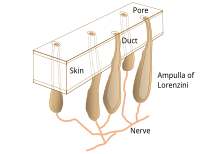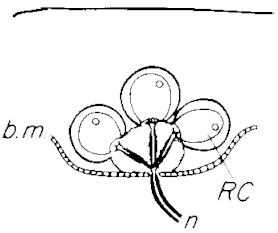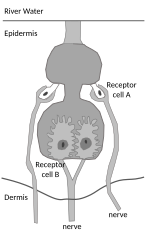Electroreception and electrogenesis
Electroreception and electrogenesis are the closely related biological abilities to perceive
The electroreceptive ampullae of Lorenzini evolved early in the history of the vertebrates; they are found in both cartilaginous fishes such as sharks, and in bony fishes such as coelacanths and sturgeons, and must therefore be ancient. Most bony fishes have secondarily lost their ampullae of Lorenzini, but other non-homologous electroreceptors have repeatedly evolved, including in two groups of mammals, the monotremes (platypus and echidnas) and the cetaceans (Guiana dolphin).
History
In 1678, while doing dissections of sharks, the Italian physician Stefano Lorenzini discovered organs on their heads now called ampullae of Lorenzini. He published his findings in Osservazioni intorno alle torpedini.[3] The electroreceptive function of these organs was established by R. W. Murray in 1960.[4][5]
In 1921, the German anatomist Viktor Franz described the knollenorgans (tuberous organs) in the skin of the elephantfishes, again without knowledge of their function as electroreceptors.[6]
In 1949, the Ukrainian-British zoologist Hans Lissmann noticed that the African knife fish (Gymnarchus niloticus) was able to swim backwards at the same speed and with the same dexterity around obstacles as when it swam forwards, avoiding collisions. He demonstrated in 1950 that the fish was producing a variable electric field, and that the fish reacted to any change in the electric field around it.[2][7]
Electrolocation
Electroreceptive animals use the sense to locate objects around them. This is important in ecological niches where the animal cannot depend on vision: for example in caves, in murky water, and at night. Electrolocation can be passive, sensing electric fields such as those generated by the muscle movements of buried prey, or active, the electrogenic predator generating a weak electric field to allow it to distinguish between conducting and non-conducting objects in its vicinity.[9]
Passive electrolocation
In passive electrolocation, the animal senses the weak
Active electrolocation
In active electrolocation,
Many of these fish, such as Gymnarchus and Apteronotus, keep their body rather rigid, swimming forwards or backwards with equal facility by undulating fins that extend most of the length of their bodies. Swimming backwards may help them to search for and assess prey using electrosensory cues. Experiments by Lannoo and Lannoo in 1993 support Lissmann's proposal that this style of swimming with a straight back works effectively given the constraints of active electrolocation. Apteronotus can select and catch larger Daphnia water fleas among smaller ones, and they do not discriminate against artificially-darkened water fleas, in both cases with or without light.[7][15]
These fish create a potential usually smaller than one
Active electrolocation relies upon tuberous electroreceptors which are sensitive to high frequency (20-20,000
Elephantfish emit short pulses to locate their prey.
-
Electrolocation of capacitative and resistive objects in elephantfish. The fish emits brief pulses from its electric organ; its electroreceptors detect signals modified by the electrical properties of the objects around it.[1]
-
For the elephantfish, the electric organ in the tail (blue) generates an electric field (cyan). This is sensed by electroreceptors in the skin, including two electric pits (foveas) to actively search and inspect objects. Shown are the field distortions created by two different types of objects: a plant that conducts better than water (green) and a non-conducting stone (brown).[19]
The Gymnotiformes, including the glass knifefish (Sternopygidae) and the electric eel (Gymnotidae), differ from the Mormyridae in emitting a continuous wave, approximating a sine wave, from their electric organ. As in the Mormyridae, the generated electric field enables them to discriminate accurately between capacitative and resistive objects.[1]

Electrolocation of capacitative and resistive objects in glass knifefish. |

The electric organs occupy much of its body.They can discharge both weakly for electrolocation and strongly to stun prey. |
Electrocommunication

Weakly electric fish can communicate by modulating the electrical waveform they generate. They may use this to attract mates and in territorial displays.[21] Electric catfish frequently use their electric discharges to ward off other species from their shelter sites, whereas with their own species they have ritualized fights with open-mouth displays and sometimes bites, but rarely use electric organ discharges.[22]
When two glass knifefishes (Sternopygidae) come close together, both individuals shift their discharge frequencies in a jamming avoidance response.[13]
In bluntnose knifefishes, Brachyhypopomus, the electric discharge pattern is similar to the low voltage electrolocative discharge of the electric eel, Electrophorus. This is hypothesized to be Batesian mimicry of the powerfully-protected electric eel.[20] Brachyhypopomus males produce a continuous electric "hum" to attract females; this consumes 11–22% of their total energy budget, whereas female electrocommunication consumes only 3%. Large males produced signals of larger amplitude, and these are preferred by the females. The cost to males is reduced by a circadian rhythm, with more activity coinciding with night-time courtship and spawning, and less at other times.[23]
Fish that prey on electrolocating fish may "eavesdrop"[24] on the discharges of their prey to detect them. The electroreceptive African sharptooth catfish (Clarias gariepinus) may hunt the weakly electric mormyrid, Marcusenius macrolepidotus in this way.[25] This has driven the prey, in an evolutionary arms race, to develop more complex or higher frequency signals that are harder to detect.[26]
Some shark embryos and pups "freeze" when they detect the characteristic electric signal of their predators.[10]
Evolution and taxonomic distribution
In
Electric organs have evolved at least eight separate times, each one forming a clade: twice during the evolution of cartilaginous fishes, creating the electric skates and rays, and six times during the evolution of the bony fishes.[28] Passively-electrolocating groups, including those that move their heads to direct their electroreceptors, are shown without symbols. Non-electrolocating species are not shown.[27] Actively electrolocating fish are marked with a small yellow lightning flash ![]() and their characteristic discharge waveforms.[29] Fish able to deliver electric shocks are marked with a red lightning flash
and their characteristic discharge waveforms.[29] Fish able to deliver electric shocks are marked with a red lightning flash ![]() .[27]
.[27]
Vertebrates
|
| |||||||||||||||||||||||||||||||||||||||||||||||||||||||||||||||||||||||||||||||||||||||||||||||||||
Cartilaginous fish
Sharks and rays (Elasmobranchii) rely on electrolocation using their ampullae of Lorenzini in the final stages of their attacks, as can be demonstrated by the robust feeding response elicited by electric fields similar to those of their prey. Sharks are the most electrically sensitive animals known, responding to direct current fields as low as 5 nV/cm.[30][31][32][33]
Bony fish
Two groups of
Monotremes

The
The electroreceptive capabilities of the four species of
Dolphins
Bees
Until recently, electroreception was known only in vertebrates. Recent research has shown that bees can detect the presence and pattern of a static charge on flowers.[41]
See also
References
- ^ PMID 10210662.
- ^ PMID 16391343.
- OCLC 2900213.
- PMID 13727039.
- PMID 14477490.
- ^ Franz, Viktor (1921). "Zur mikroscopischen Anatomie der Mormyriden". Zoologisch Jahrbuch Abteilung für Anatomie und Ontogonie. 42: 91–148.
- ^ a b Lissmann, Hans. "Continuous Electrical Signals from the Tail of a Fish, Gymnarchus Niloticus Cuv", in: Nature, 167, 4240 (1951), pp. 201–202.
- "The Mechanism of Object Location in Gymnarchus Niloticus and Similar Fish", in: Journal of Experimental Biology, 35 (1958), pp. 451–486. (with Ken E. Machin)
- "The Mode of Operation of the Electric Receptors in Gymnarchus Niloticus", in: Journal of Experimental Biology37:4 (1960), pp. 801–811. (with Ken E. Machin)
- "Electric Location by Fishes", in: Scientific American, 208, pp 50–59, March 1963.
- "The Mechanism of Object Location in Gymnarchus Niloticus and Similar Fish", in:
- ^ .
- ^ S2CID 73442571.
- ^ .
- .
- ^ ISBN 978-0-8493-2022-4.
- ^ a b c Bullock, Theodore H.; Hamstra, R. Jr.; Scheich, H. (1972). "The jamming avoidance response of high frequency electric fish". Journal of Comparative Physiology (77): 1–22.
- ^ PMID 16943504.
- S2CID 109426.
- PMID 5219479.
- PMID 19772622.
- S2CID 2975352.
- PMID 24744740.
- ^ S2CID 204994529.
- PMID 10210663.
- .
- S2CID 14310938.
- PMID 25994677.
- .
- S2CID 6240530.
- ^ S2CID 15603518.
- S2CID 216572032.
- .
- PMID 17894175. Retrieved 2 December 2013.
- PMID 22606250.
- PMID 22497416.
- PMID 24695492.
- ^ a b c "Electroreception in fish, amphibians and monotremes". Map of Life. 2010. Retrieved 12 June 2013.
- PMID 26521183.
- ^ Froese, Rainer; Pauly, Daniel (eds.) (2005). "Electrophorus electricus" in FishBase. December 2005 version.
- ^ S2CID 4362785.
- ^ PMID 10210685.
- PMID 9720114.
- PMID 21795271.
- S2CID 23742599.
Further reading
- Bullock, Theodore Holmes (2005). Electroreception. New York: OCLC 77005918.





![Electrolocation of capacitative and resistive objects in elephantfish. The fish emits brief pulses from its electric organ; its electroreceptors detect signals modified by the electrical properties of the objects around it.[1]](http://upload.wikimedia.org/wikipedia/commons/thumb/f/f2/Electroreception_of_Capacitative_and_Resistive_Objects_in_Elephantfish.svg/447px-Electroreception_of_Capacitative_and_Resistive_Objects_in_Elephantfish.svg.png)
![For the elephantfish, the electric organ in the tail (blue) generates an electric field (cyan). This is sensed by electroreceptors in the skin, including two electric pits (foveas) to actively search and inspect objects. Shown are the field distortions created by two different types of objects: a plant that conducts better than water (green) and a non-conducting stone (brown).[19]](http://upload.wikimedia.org/wikipedia/commons/thumb/d/d9/Scene_analysis_in_electroreception_coloured.jpg/690px-Scene_analysis_in_electroreception_coloured.jpg)


